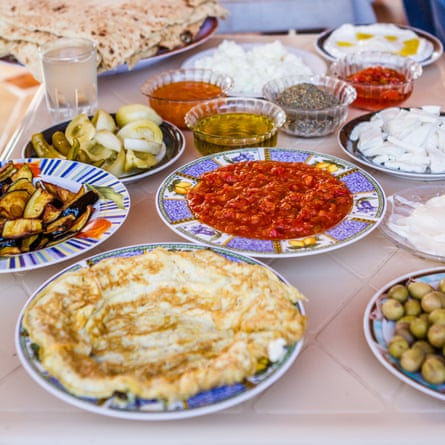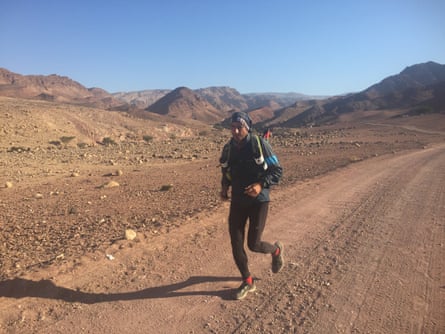Running and travelling can be the perfect partners – whether that’s an early morning exploratory jog on a business trip or a dedicated holiday built around a multi-stage race. New routes, scenery and challenges can help enliven one’s love of running, while seeing the world on foot offers an enhanced perspective.
For me, the steps up to the Mtatsminda plateau outside Tbilisi and the colonial racecourse in Mumbai at sunset stand out as all-time favourites; the chaotic streets of Lagos were equally memorable, but for different reasons. To avoid disappointment, I now fly everywhere with a pair of trainers in my hand luggage. But at the start of November I, alongside Jordanian runner Mohammad Al-Sweity, took the combination of running or travelling a step (well, a few actually) further by jogging the Jordan Trail, a new 650km (400-mile) route stretching the entire length of the country.
Here are five reasons why the experience might appeal to everyone from weekend walkers to elite ultra-runners…
1 It’s one long sightseeing tour
To say that the Jordan Trail passes some interesting places would be an absurd understatement. The trail is steeped in history, traversing some of the oldest continually used paths in the world; this is, after all, part of the fertile crescent where civilisation first developed.

Starting amid the spectacular Roman ruins of Gadara at Um Qais, with the Golan Heights and the Sea of Galilee in the background, the trail weaves it way south. Along the way it passes the crusader castles of Ajloun and Karak, the biblical site of Mount Nebo, the stunning city of Petra and the protected deserts of Wadi Rum.
As well as these headline attractions are countless more understated sites of interest. At Beit Edis, I tripped over some stones in a field and discovered I had stumbled upon the site of a Byzantine church, complete with exposed mosaic floors. In terms of historical routes, the Jordan Trail would be hard to beat.
2 You can eat your body weight in delicious food
According to Strava, I was burning 6,000-8,000 calories each day. That’s a lot of hummus. Fortunately, I had the privilege of being supported by the Jordan Trail Association. Several times a day, a pickup truck would intercept me (where feasible) to provide sustenance and encouragement (along with repeated offers of cigarettes). In the evenings, I would enjoy what can only be described as high-end glamping – a far cry from the self-supported attempt that I had originally envisaged.

Jordanian food is ideal running fuel. Any cuisine that includes fudge for breakfast (halaweh) will always win my affection. Along with fresh bread, eggs, hummus, cheese, olives and honey, it provided the ideal start to the day. On the trail, I subsisted on occasional Tribe bars and frequent cups of sweet black tea. In the evenings, I munched my way through mountains of rice, chicken and salads, followed by gooey honey and nuts.
3 Not racing can be an absolute pleasure
Perhaps it reflects my narrow-minded competitiveness but the novelty of running without racing was a revelation. Much of my running in exotic places has been in races and, no matter how much I tell myself otherwise, I always end up striving.
On the Jordan Trail it was quite different. We had a target destination each day, but whether it took six hours or eight hours was irrelevant. This left plenty of time to marvel at the scenery, stop for tea with passing Bedouin shepherds or simply misread my GPS and end up on an inadvertent detour.
At times I chose to increase the tempo – on the shaded trail of Zubia forest or on the hard sands of Wadi Rum – and occasionally a guard dog tasked with protecting the livestock from wolves and hyenas would show too much interest, so I would switch to an impromptu fartlek session. But, in general, I simply listened to my body and ran or walked or rested accordingly.
Whereas at the end of stage races participants often look like they have just been released from a gulag, I felt far better at the end of the Jordan Trail than at the beginning – the effect no doubt of fresh air, exercise, plenty of sleep and good food (and perhaps the absence of alcohol).

4 You will be rediscovering a timeless tradition
Until the 20th century, long journeys on foot would have been a necessity for many (and still are for some today). Whether walking to Mecca or Rome on a pilgrimage, undertaking voluntary or involuntary migration, or simply conducting trade, our ancestors regularly embarked on weeks or months of walking. Today, most of our lives consist of sedentary stagnation interspersed with occasional, almost instantaneous relocations. While this might be very convenient, it discontents us from the real meaning of distances and the gradual transitions of scenery, people and culture. It also deprives us of an opportune time for reflection.
Our historic relationship with journeys by foot perhaps help to explain the increasing popularity of through-hiking; alongside, of course, the emergence of the middle-aged gap year. From the Appalachian Trail to Offa’s Dyke to el Camino de Santiago de Compostela, increasing numbers of people are choosing to go for long walks. And for the time-poor, energy-rich, through-running offers a convenient alternative.
5 It finishes with a swim in the Red Sea
I arrived in the town of Aqaba, torn between satisfaction that I had survived intact (the same could not be said for my shoes) and disappointment that I had run out of trail. However, plunging into the clear water of the Red Sea provided the ideal end to the expedition.
The Jordan Trail Association provides detailed information and guidelines on the route, including GPS files. Anyone accustomed to regular exercise would probably be able to complete the trail in 25-30 days and, for those inclined to run, 10-20 days is feasible. Popular sections for shorter walks include Um Qais to Ajloun and Petra to Wadi Rum.
You can see more about the first recorded run of the Jordan Trail on Instagram (@jogonalfie) and Strava.

Comments (…)
Sign in or create your Guardian account to join the discussion